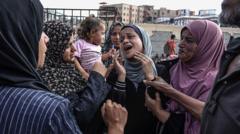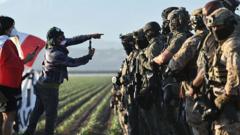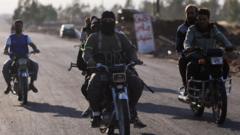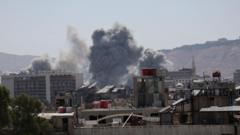The turmoil in Gaza deepens as the health authorities report 32 new deaths linked to military action, cumulating to over 670 casualties since the introduction of a contentious food distribution system.
Gaza's Humanitarian Crisis Intensifies Amid Rising Death Toll

Gaza's Humanitarian Crisis Intensifies Amid Rising Death Toll
The Gaza Health Ministry reports escalating violence as Israeli military actions claim more lives near food distribution sites.
In the throes of ongoing conflict, the Gazan health authorities announced on Saturday that at least 32 lives were lost due to Israeli military actions in southern Gaza. Reports indicate that these fatalities occurred near a food distribution site operated by the Gaza Humanitarian Foundation, a group established partly by Israeli officials.
The Israeli military is currently investigating these claims, alongside the Gaza Humanitarian Foundation, highlighting the complexities of the conflict. The Nasser Medical Complex in southern Gaza confirmed receiving 29 bodies from distribution points, yet did not clarify the circumstances surrounding their deaths.
This violent episode is part of a larger narrative tied to a controversial food distribution system launched by Israel two months ago. The United Nations has reported an alarming toll of over 670 Palestinians killed near sites linked to the new system, first implemented in May.
The Israeli military replaced the United Nations' previously extensive food aid framework with a more centralized approach that restricts access to a select few distribution sites. This move, aimed at preventing Hamas from misappropriating food supplies, has instead turned the search for food into what many describe as a death trap, as crowds of desperate citizens congregate in proximity to armed troops.
Numerous aid organizations assert that this system has exacerbated existing hunger issues in Gaza, a nation under a severe blockade that lasted 80 days earlier this year, halting all food and fuel supplies. The United Nations Relief and Works Agency for Palestine Refugees in the Near East (UNRWA) reported alarming results from screenings in June that indicated nearly one in ten children in the region are suffering from malnourishment.
Despite claims of infrequent violence at aid sites by the Gaza Humanitarian Foundation, the use of deadly force by Israeli soldiers remains a glaring concern, with reports of gunfire directed at crowds. Israeli officials have suggested that the reported death tolls may be exaggerated, while the humanitarian agencies emphasize the dire conditions facing the population in Gaza.
This escalating crisis underscores the urgent need for sustainable solutions that prioritize the well-being of civilians in the region.
The Israeli military is currently investigating these claims, alongside the Gaza Humanitarian Foundation, highlighting the complexities of the conflict. The Nasser Medical Complex in southern Gaza confirmed receiving 29 bodies from distribution points, yet did not clarify the circumstances surrounding their deaths.
This violent episode is part of a larger narrative tied to a controversial food distribution system launched by Israel two months ago. The United Nations has reported an alarming toll of over 670 Palestinians killed near sites linked to the new system, first implemented in May.
The Israeli military replaced the United Nations' previously extensive food aid framework with a more centralized approach that restricts access to a select few distribution sites. This move, aimed at preventing Hamas from misappropriating food supplies, has instead turned the search for food into what many describe as a death trap, as crowds of desperate citizens congregate in proximity to armed troops.
Numerous aid organizations assert that this system has exacerbated existing hunger issues in Gaza, a nation under a severe blockade that lasted 80 days earlier this year, halting all food and fuel supplies. The United Nations Relief and Works Agency for Palestine Refugees in the Near East (UNRWA) reported alarming results from screenings in June that indicated nearly one in ten children in the region are suffering from malnourishment.
Despite claims of infrequent violence at aid sites by the Gaza Humanitarian Foundation, the use of deadly force by Israeli soldiers remains a glaring concern, with reports of gunfire directed at crowds. Israeli officials have suggested that the reported death tolls may be exaggerated, while the humanitarian agencies emphasize the dire conditions facing the population in Gaza.
This escalating crisis underscores the urgent need for sustainable solutions that prioritize the well-being of civilians in the region.





















